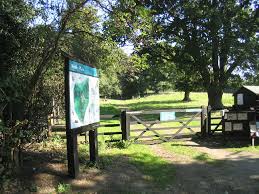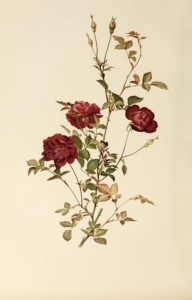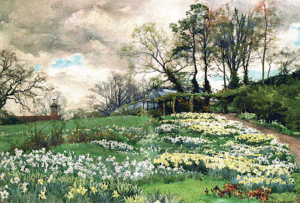Ellen Ann Willmott
Botanist
Watercolour of Ellen Willmott’s garden by Alfred Parsons R.A. (Image from Wikimedia Commons)
- BORN 19th August 1858, Heston, Middlesex
- DIED 27th September 1934, Great Warley, Brentwood, Essex
- WORKED Warley Gardens, Brentwood, Essex
- HONOURS One of only two women recipients of the Royal Horticultural Society’s first Queen Victoria Medal of Honour; More than 60 plants were named after her and her gardens at Warley; One of the earliest women elected to the Linnean Society (1904); Won distinguished medals from France and the Royal National Rose Society.
- MINERVA SCIENTIFICA PROJECT Echoes from Essex 2020
Entry by Dr Patricia Fara, Emeritus Fellow of Clare College Cambridge and member of the British Society for the History of Science.
PODCAST
A wealthy horticulturalist with a passion for roses, Ellen Willmott (1858-1934) developed her family garden into a world-famous botanical centre and funded international expeditions to discover new plants. Today her garden has transformed into Warley Place Nature Reserve, which is a magical natural landscape well worth a visit. In place of Willmott’s 100 immaculately dressed gardeners, the reserve is maintained by Essex Wildlife Trust and their committed volunteers. For more Minerva Scientifica podcasts click here.
Artistic Connections
Her beautiful gardens reveal her artistic creativity. She was a keen photographer and woodworker, specialising in ornamental turning. She was also an enthusiastic musician: she bought several fine instruments, including a Stradivarius violin
Music
Title: Moon of Heaven
Composer: ELSPETH MANDERS
Words by: Jammam Shud, from ‘The Rubaiyat of Omar Khayyam’ a collection of 11th-century Persian poetry
Written in: August 2020
For: Soprano, Mezzo Soprano, Countertenor, Tenor
Commissioned by: electric voice theatre
Performed by: Soprano – Frances Lynch; Mezzo Soprano – Simone Ibbett Brown; Countertenor – David Sheppard; Tenor – Julian Stocker
First Performed: as part of “Soundings from Essex” events online during the Covid-19 outbreak, 10th August 2020
The music reflects upon Ellen Willmott’s life at Warley Place. Willmott quoted this text in her obituary for her younger sister Rose published in the Essex Naturalist in 1922.
The Moon of Heaven is rising once again
How oft hereafter rising shall she look
Through this same garden after me – in vain
Title: A Sweet Country Life
Composer: IMOGEN HOLST
Words: Folk song from Gloucestershire
Arranged: 1937
For: SATB unaccompanied
Performed by: Frances M Lynch (soprano), David Sheppard (counter-tenor), Julian Stocker (tenor), Gwion Thomas (baritone)
Published by: Published Novello, 1937 (Novello’s Part Song Book, no. 1497)
This song was one of many collected by Cecil J. Sharp, founder of the English Folk Dance Society.
It’s fresh, lively and old English feel is the perfect introduction to Willmott and Warley Place, given her own involvement in group singing and it’s expression of the delights of living in the country.
Education
For several years she attended an exclusive Catholic convent school: Gumley House in Isleworth.
Occupations
From the age of 17, she was dedicated to the science of horticulture and improving the gardens at Warley). On her 21st birthday, her father allowed to build an artificial gorge and pool. Thanks to a large legacy, she purchased properties in France and Italy, and poured her money into developing their gardens as well. She cultivated around 100,000 different types of plant, and also financed botanical expeditions to China and the Middle East. Her garden partially survives as Warley Place Nature Reserve.

Warley Place Nature Reserve, Great Warley. (Image by John Winfield from geograph.org.uk).
Scientific Achievement
Her two-volume Genus Rosa of 1910-14 provided an authoritative and comprehensive study of roses, including 132 lovely watercolour illustrations.

The genus rosa, London, John Murray,1914 (Image by Biodiversity Heritage Library on flickr)
Did You Know?
She employed over 100 gardeners, all of them men except during the War. She was a strict employer, but imposed the same high standards on her own contributions.
She apparently became increasingly eccentric, and rumours circulated that she kept a revolver in her handbag. There seems to be no foundation in the story that she scattered seeds of the giant thistles now known as ‘Miss Willmott’s ghosts’ in her friends’ gardens.
By spending her large inheritance, she created one of Britain’s most beautiful gardens. It ran to ruin after being sold to a property developer, but fortunately he was denied permission to build a housing estate.
An Inspiring Woman
Ellen Willmott was passionate about plants and she took advantage of her huge wealth to create a world-famous garden and to finance botanical exploration. Her influence continues in the high number of plants named after her. The extensive grounds she owned and beautified survive as a nature preserve, but sadly no longer exist as gardens demonstrating her exceptional skill and profound knowledge.



